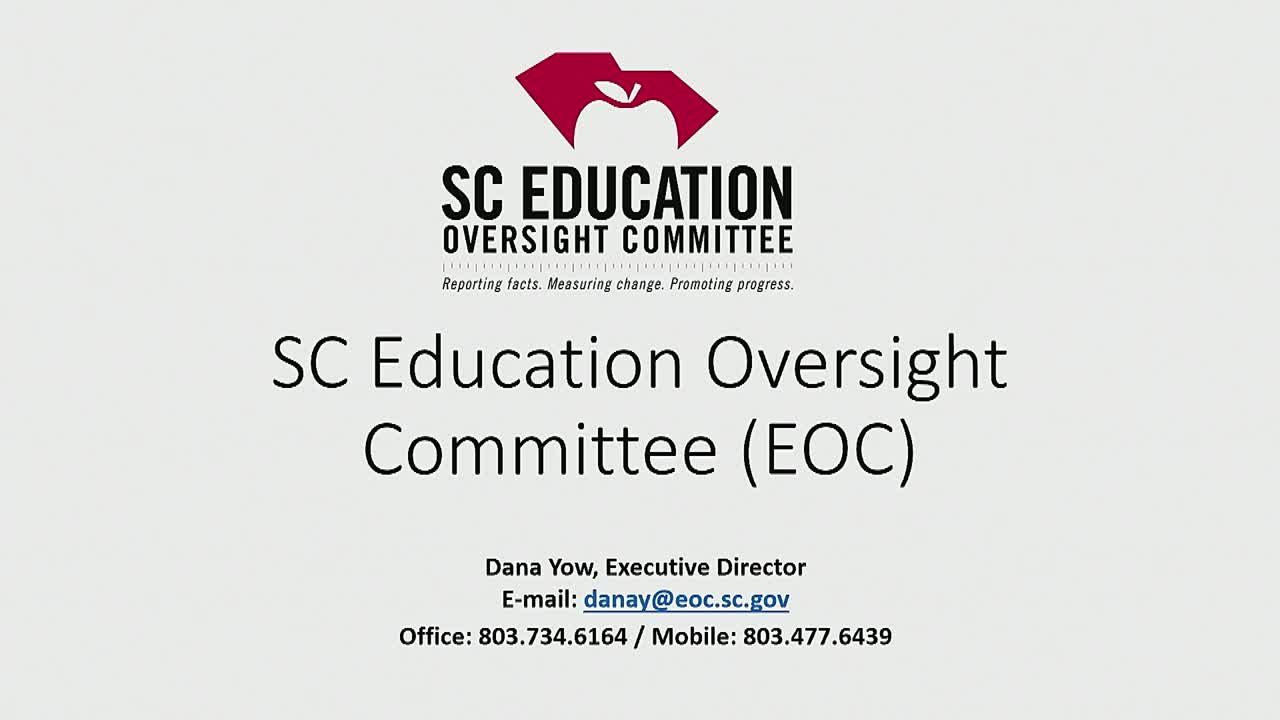Education Oversight Committee: 85.4% On‑Time Graduation, EOC Flags Gaps in College‑and‑Career Readiness
April 30, 2025 | 2025 Legislative Meetings, South Carolina
This article was created by AI summarizing key points discussed. AI makes mistakes, so for full details and context, please refer to the video of the full meeting. Please report any errors so we can fix them. Report an error »

Dana Yao, executive director of the Education Oversight Committee, told the House Education and Public Works Committee that the statewide on‑time high school graduation rate for 2024 was 85.4 percent and that the committee is focused on closing gaps in college and career readiness for graduates.
The Education Oversight Committee (EOC) approves content standards and the statewide assessments used in accountability for the four tested subjects (English language arts, math, science and social studies), issues annual school report cards (legislatively required by Oct. 15), and evaluates state‑funded programs such as full‑day 4K, the Educational Credit for Exceptional Needs program and the teacher loan program. Yao said the EOC also issues annual EIA recommendations to the General Assembly and maintains an education data dashboard at dashboardsc.sc.gov to help lawmakers and the public review performance by district and school.
Yao described EOC evaluations in progress or completed: a study of rural teacher recruitment incentives (EIA investment of $7,600,000), analysis of alternative modes of instruction (face‑to‑face courses showed stronger achievement in the EOC’s last review), and work on chronic absenteeism. “In 22–23, 23 percent of students were actually chronically absent,” Yao said, describing chronic absenteeism as missing about 10 percent of the school year and a factor that depresses academic performance.
Committee members pressed for more detail on readiness metrics and workforce issues. Representative Bradley and others questioned how many graduates are “college and career ready”; members referenced differing numbers during the briefing (one member interpreted the slides as about 30 percent; Yao also referred to a chart representation described elsewhere in the presentation). Yao agreed to supply the committee with the slide deck and follow‑up data, and the EOC offered to provide additional figures on rural teacher turnover when available.
Yao said the EOC is small—about eight full‑time equivalent staff— and described the EOC’s role in cyclical accountability review and targeted special studies at the legislature’s direction. She encouraged members to use the EOC dashboards for local and statewide questions and to nominate stakeholders for the committee’s upcoming cyclical accountability review.
The presentation concluded with an offer to provide the slides and additional data to committee members and to meet individually on specific questions.
The Education Oversight Committee (EOC) approves content standards and the statewide assessments used in accountability for the four tested subjects (English language arts, math, science and social studies), issues annual school report cards (legislatively required by Oct. 15), and evaluates state‑funded programs such as full‑day 4K, the Educational Credit for Exceptional Needs program and the teacher loan program. Yao said the EOC also issues annual EIA recommendations to the General Assembly and maintains an education data dashboard at dashboardsc.sc.gov to help lawmakers and the public review performance by district and school.
Yao described EOC evaluations in progress or completed: a study of rural teacher recruitment incentives (EIA investment of $7,600,000), analysis of alternative modes of instruction (face‑to‑face courses showed stronger achievement in the EOC’s last review), and work on chronic absenteeism. “In 22–23, 23 percent of students were actually chronically absent,” Yao said, describing chronic absenteeism as missing about 10 percent of the school year and a factor that depresses academic performance.
Committee members pressed for more detail on readiness metrics and workforce issues. Representative Bradley and others questioned how many graduates are “college and career ready”; members referenced differing numbers during the briefing (one member interpreted the slides as about 30 percent; Yao also referred to a chart representation described elsewhere in the presentation). Yao agreed to supply the committee with the slide deck and follow‑up data, and the EOC offered to provide additional figures on rural teacher turnover when available.
Yao said the EOC is small—about eight full‑time equivalent staff— and described the EOC’s role in cyclical accountability review and targeted special studies at the legislature’s direction. She encouraged members to use the EOC dashboards for local and statewide questions and to nominate stakeholders for the committee’s upcoming cyclical accountability review.
The presentation concluded with an offer to provide the slides and additional data to committee members and to meet individually on specific questions.
View full meeting
This article is based on a recent meeting—watch the full video and explore the complete transcript for deeper insights into the discussion.
View full meeting